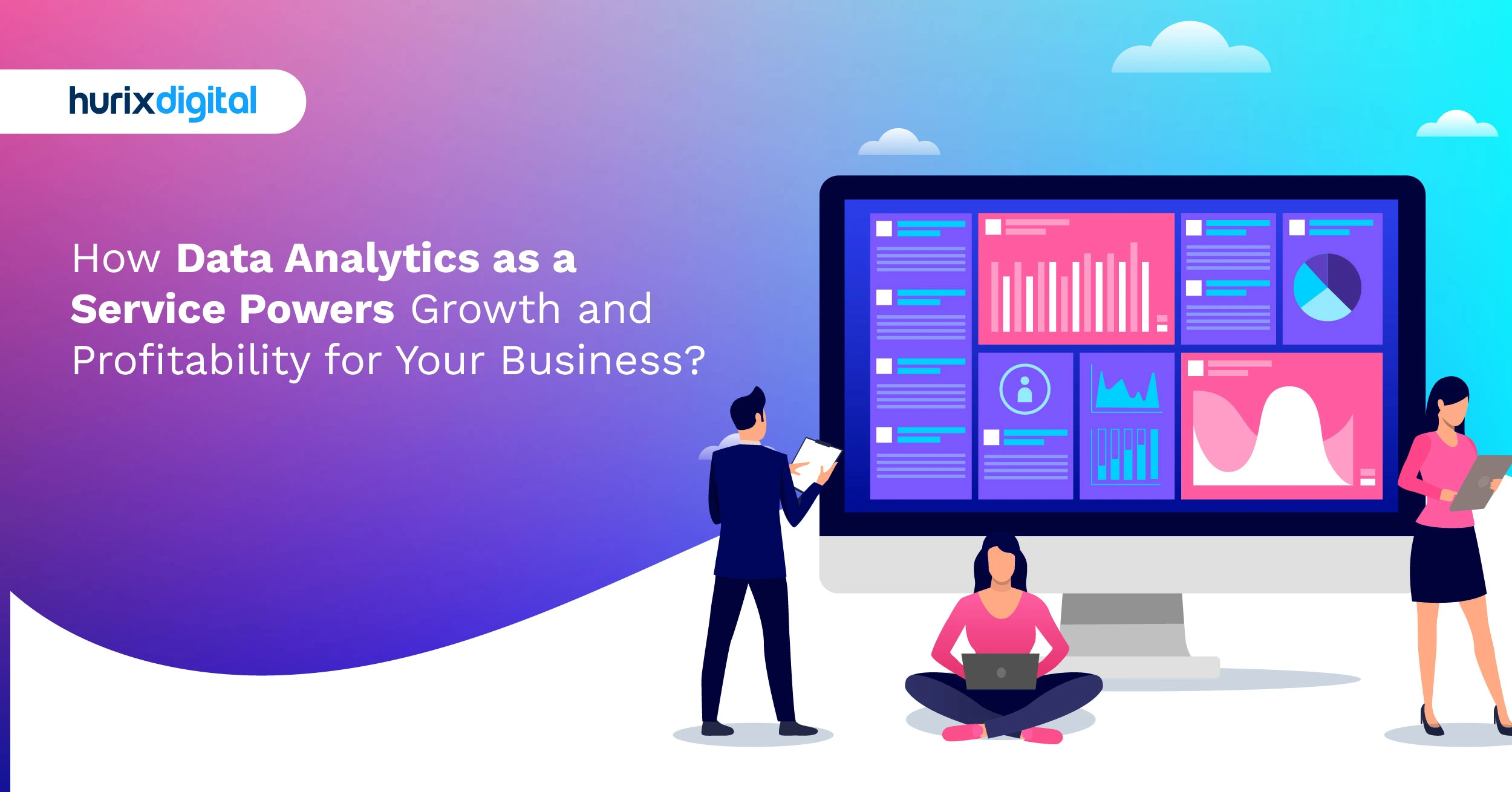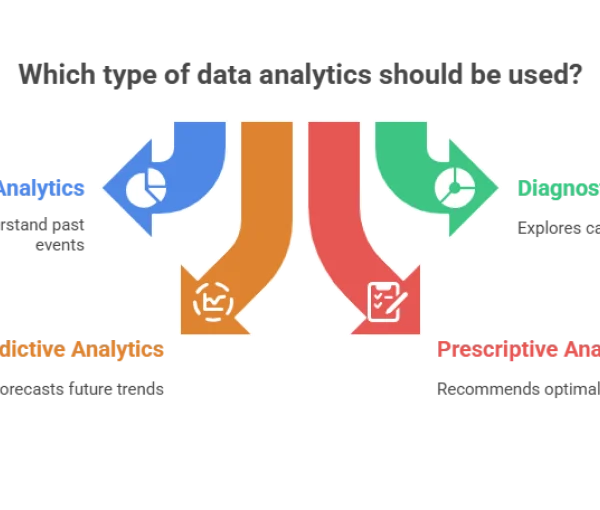
How Data Analytics as a Service Powers Growth and Profitability for Your Business?
Summarize with:
Data has become the cornerstone of successful corporate operations in today’s digital landscape. By using the vast information that data analytics as a service offers, organizations can make educated decisions and drive strategic growth trajectories.
However, many businesses find it extremely difficult to handle the intricacies involved in data analysis. Data analytics as a service meets this crucial demand by providing specialized guidance that releases the latent potential in an organization’s data assets. Businesses increasingly turn to cloud data analytics solutions to utilize scalable processing capacity and sophisticated analytical tools to derive insightful conclusions from enormous datasets.
According to analyst forecasts, the worldwide big data analytics industry is expected to develop significantly and reach a valuation of $745.15 billion by 2030, with a CAGR of 13.5%. These specific services provide a multifaceted strategy to help companies utilize data to make strategic decisions.
Let us learn more about the relevance of enhancing data analytics solutions in this guide!
Table of Contents:
- How Does Data Analytics Work?
- Different Data Analytics Types
- The Impact of Data Analytics as a Service on Enterprise Transformation
- Key Technologies Surrounding Data Analytics Works
- Key Benefits of Prioritizing Analytics as a Service in Business
- Conclusion
How Does Data Analytics Work?
Several industries are using Data Analytics. Let us take a look:
- Travel brands use data analytics to enhance customer experience, reduce risks, get better projections and insights, and frame more competitive pricing structures.
- 72% of manufacturing businesses rely on advanced analytics to improve productivity.
- The big data analytics in education market was valued at $13.58 billion in 2020 and is expected to reach $57.14 billion by 2030, at a CAGR of 15.3%.
- Big Data analytics for the healthcare industry is expected to reach $79.23 billion by 2028.
- Big Data in Supply Chain Management is expected to cross $7.1 billion globally by 2027.
Here is how different business leaders use data analytics:
Step 1: Collecting Data
The first step is to collect data from various internal and external sources. These sources include customer interactions, social media comments, testimonials, surveys, and financial records. Here are some tips:
- Identify Relevant Data Sources
- Invest in Data Collection Tools
- Establish Data Governance Practices
- Ensuring Data is Relevant
Step 2: Organizing Data
Raw data is often unstructured. Between 80%- 90% of the total volume of data generated is unstructured, and 95% of businesses find it a major challenge.
Data analysts clean and organize this information. The process includes removing errors and ensuring consistency. Here are some tips:
- Data Cleaning: Data analysts must organize the data to make it accurate for analysis.
- Data Validation: Validate data to ensure it is relevant. Verify it against multiple sources or compare it to industry standards. This will help maintain accuracy.
- Focus on Data Quality: High-quality data is crucial for reliable insights.
Step 3: Transforming and Analyzing Data
Data is transformed into formats suitable for analysis, and then several techniques are applied to uncover trends and patterns. Some of these techniques include:
- Choose the Right Analytical Techniques.
- Leverage Data Visualization Tools.
- Embrace Storytelling with Data.
Step 4: Presenting Insights
After the findings are noted, they are translated into comprehensible visual reports. This is done so that all stakeholders can easily access them. Here are some tips:
- Customize your presentation style for different audiences.
- Present data in an actionable way that encourages a data-driven culture.
- Employees should be encouraged to ask questions.
- Business practices should be improved consistently based on data insights.
Different Data Analytics Types
Here are some important types of data analytics:

1. Descriptive Data Analytics
This summarizes and describes the data, revealing what happened. It includes basic statistics and visualizations, which answer questions like “What happened?” and “How much?”
2. Diagnostic Analytics
This type explores why something happened. It uncovers causes and hidden relationships through data mining.
3. Predictive Analytics
This type uses historical data and statistical models to forecast future trends, allowing businesses to make informed decisions.
4. Prescriptive Analytics
This type predicts future outcomes and also recommends optimal actions.
The Impact of Data Analytics as a Service on Enterprise Transformation
Traditional data analytics solutions often come with limitations. DAaaS, however, is transforming how enterprises can leverage their data, leading to significant benefits.
1. Streamlining Enterprise Operations
One of the fundamental benefits of Data Analytics as a Service (DAaaS) is its ability to improve business operational efficiency.
DAaaS simplifies the process of managing enterprise data, cutting down on the time and resources typically needed for collecting, processing, and analyzing data. This streamlining effect is achieved through several primary features:
- Automation: Automation through DAaaS solutions can streamline repetitive tasks like data collection, cleaning, and processing. It allows for more resources to be available in the organization and reduces the chance of human mistakes.
- Enhanced Data Quality: DAaaS platforms often include data quality checks and cleaning procedures to ensure the data is precise and uniform, leading to more dependable outcomes and better decision-making.
- Quicker Understanding: DAaaS streamlines the process of obtaining actionable insights by simplifying data management. It enables companies to quickly respond to shifting market conditions and make data-driven decisions more efficiently.
2. Informed Decision-Making
Traditionally, businesses relied on limited datasets and intuition to guide strategic choices. DAaaS solutions transform this method by allowing organizations to analyze large volumes of data almost instantly.
Through advanced analytics tools, companies can stay up-to-date with constantly evolving customer needs and market trends. This newly acquired ability to access extensive data enables businesses to:
- Make Wiser Decisions: Businesses can develop strategic plans based on verifiable evidence and transcend conjecture by utilizing the insights obtained from data analysis. DAaaS helps reduce potential risks and identify new opportunities by enabling the exploration of intricate trends and patterns.
- Improve Operations: Data analysis can identify workflow and process inefficiencies. By pinpointing areas that need improvement, businesses may optimize their processes, simplify the distribution of resources, and eventually increase overall performance.
- Obtain a Competitive Edge: The capacity to use data insights is critical in today’s data-driven business. DAaaS enables enterprises to make decisions more quickly and intelligently than their competitors, allowing them to capitalize on new trends and adapt to shifting market conditions.
- Data Visualization: With its user-friendly dashboards and reports, DAaaS simplifies the data visualization procedure. Thanks to these technologies, decision-makers at all levels of the organization may now readily access and understand complex data sets. Prominent organizations are utilizing big data and analytics for real-time data visualization, which supports informed decision-making and advanced forecasting.
3. Cost Optimization
Data analysis as a service provides a new way for businesses to cut costs. In 2023, data and analytics initiatives resulted in a measurable return on investment for 91.9% of organizations.
Through advanced analytics capabilities, DAaaS enables companies to identify and address inefficiencies that could impact their bottom line. Here is how a data analysis service promotes a culture of cost optimization:
- Optimized Data Storage: DAaaS systems, frequently hosted on the cloud, provide affordable storage for large amounts of data. Data administration is made simpler and no longer requires costly on-premise infrastructure.
- Real-Time Insights: Data analytics as a service is essentially a complete business intelligence and data analytics solution that allows for the identification of inefficiencies and waste by providing real-time analysis of operational data. Owing to this proactive strategy, they can make necessary corrections and allocate resources more efficiently, which significantly reduces costs.
- Data-Driven Decisions: Businesses can make informed choices on pricing, product development, and marketing campaigns by using data to inform their decisions, thereby reducing financial risks and increasing investment returns.
4. Enhanced Revenue Streams
Data analytics as a service (DAaaS) positions itself as a strategic tool for driving profitability. By analyzing customer data and market trends, DAaaS enables revenue enhancement and allows businesses to achieve sustainable financial success in a dynamic marketplace.
- Customize Offerings: Data analytics enables companies to identify consumer preferences and behavioral patterns, allowing them to tailor goods and services to specific client groups, which boosts client satisfaction and loyalty.
- Optimize Marketing Strategies: Companies may examine campaign performance statistics to determine which marketing channels are most successful and adjust their strategy. This focused approach can achieve a higher return on investment and more effective use of marketing resources.
- Forecast Industry Trends: Data analytics tools facilitate the identification of emerging consumer demands and industry trends. This insight enables companies to develop cutting-edge products and services that resonate with their target market, providing them with a sustained competitive advantage and increased sales.
5. Deliver Superior Products and Services
Through advanced analytics capabilities, DAaaS enables businesses to understand their target audience and tailor their offerings accordingly, driving repeat business and achieving sustainable growth in a highly competitive landscape. This shift towards customer-centricity manifests in the following ways:
- Improved Product Development: Analyzing customer data and identifying purchasing patterns, preferences, and needs enables companies to create products and services that appeal to their desired demographic. This data-based approach reduces the chances of product failure and maximizes customer satisfaction.
- Tailored Marketing Tactics: By using data analysis as a service business model, we can examine consumer behavior data and develop targeted marketing initiatives. Companies can harness this data to tailor their communication, enhance advertising campaigns, and boost conversion rates.
- Enhanced Customer Experience: Customer interactions and service experience are better perceived through data analysis. Businesses can utilize this knowledge to identify areas for improvement, streamline customer touchpoints, and enhance overall customer satisfaction.
6. Intelligent Automation
Analytics as a service extends significant business value for enterprises by enabling seamless integration with advanced technologies. It propels enterprises towards the future of intelligent automation, facilitating dramatic improvements in efficiency and productivity.
- Improved AI Development: DAaaS makes gathering and examining enormous datasets effortless, which lays the groundwork for creating and honing potent AI algorithms. These algorithms can personalize consumer experiences, automate tedious tasks, and promote wise decision-making throughout the company.
- Advanced Customer Service: DAaaS makes it possible to build chatbots and virtual assistants with intelligence that can quickly and effectively respond to consumer inquiries. These automated technologies improve customer satisfaction by personalizing interactions and increasing customer service availability.
- Augmented Decision-Making: Big data and analytics provide enhanced insights to support human decision-makers in gaining a deeper understanding of complex situations. It enables them to make more informed choices and achieve optimal outcomes.
- Collaborative Workflows: DAaaS facilitates the seamless integration of AI tools into existing human workflows. It enables employees to leverage the power of automation while maintaining their critical expertise and human judgment.
Key Technologies Surrounding Data Analytics Works
Key technologies involved include:
- Cloud Data Analytics: Enables scalable cloud storage, processing, and analysis of large data volumes without heavy infrastructure investment.
- Enterprise Data Management: Enhances data utilization and leads to data-driven decisions.
- Data Mining: Extracts valuable insights using AI-empowered techniques on various data types.
- Data Storage: Utilizes technologies like cloud storage for digital data retention.
- Data Lake: Repositories that store and process unstructured data. This is done in large volumes, aiming to reduce costs.
- Data Warehouse: This type stores structured data in relational databases. It then loads and processes this data using advanced analytics.
- Text Mining: Analyzes unstructured text data and retrieves valuable information from it.
Key Benefits of Prioritizing Analytics as a Service in Business
Data analysis service empowers businesses to make informed decisions and optimize various aspects of their operations. Here are some key benefits:

1. Gain Greater Insight into Target Markets
Data analytics solutions help businesses in:
- Understanding Customer Behavior: Access to digital data reveals customer preferences. Businesses can identify trends and customize products or services to meet these needs by analyzing this data.
- Improving Customer Satisfaction: In-depth knowledge of customer behavior helps improve loyalty and boost sales. Ignoring these insights can lead to losing customers to competitors who better understand their audience.
2. Boosting Revenue
Analytics as a Service helps businesses understand which products resonate with specific customer segments. This allows sales reps to focus their efforts more effectively. Historical transaction data provides insights into buying behaviors, further guiding sales strategies to prioritize high-value products.
3. Reducing Operating Costs
A data analysis service identifies wasteful processes and areas that need more funding. As business leaders, you can assess cost-cutting opportunities and adopt technologies that reduce operational expenses.
4. Improving Operational Efficiency
Analyzing customer data and feedback reveals opportunities for optimization. Businesses can refine strategies to maximize profits. Data analytics enables faster and more informed decisions that can significantly reduce reliance on intuition. This proactive approach helps identify opportunities and avoid ineffective strategies or misguided investments.
5. Risk Mitigation
Data analytics plays a crucial role in risk and enterprise data management. By analyzing historical data, businesses can identify patterns and vulnerabilities. This can help them develop strategies to mitigate risks and ensure compliance.
Let us take Meta as an example. Meta utilizes cloud data analytics to detect and respond to cybersecurity threats, ensuring a secure platform.
6. Enhancing Marketing Efforts by Better Targeting
Analytics as a Service helps determine the most effective ways to advertise products, optimize spending, and maximize impact. Collecting accurate information saves money and enhances marketing efforts. It provides insights into customer behavior and market conditions. Predictive analytics and machine learning forecast future market trends, helping companies stay ahead.
For example, Shopify uses data analytics to measure campaign performance in real-time. This helps the brands optimize budget allocation and enhance customer satisfaction through targeted strategies.
7. Gaining Competitive Advantage
Data analytics provides deep insights into customer behavior, enhancing the ability to meet customers’ needs and increase demand. Predictive modeling enables companies to strategize future investments and enhance operational efficiency.
Understand how Amazon uses data analytics to provide personalized recommendations, efficiently manage inventory, manage enterprise data, and optimize pricing. This enhances customer satisfaction and maintains a competitive edge.
8. Identifying New Product and Service Opportunities
Data Analytics as a Service helps businesses understand their audience, anticipate market needs, and identify gaps in their products or services. Real-time feedback and competitor analysis allow companies to stay competitive and meet changing consumer demands. Cloud data analytics enables leaders to utilize data visualization tools to analyze outcomes and refine their processes.
Check out EXCLUSIVE: Hurix Digital Seamlessly Stabilizes a Leading Utilities Provider’s IT Infrastructure and Services
Conclusion
Data Analytics as a Service enables businesses to make informed, data-driven decisions and solve complex problems. Enhance your business productivity by using advanced data analytics solutions today. Business leaders must utilize cloud data analytics services to transform their businesses, which can help them drive long-term growth. Adopting data analytics is essential so businesses can unlock new opportunities.
Contact Hurix Digital to discover how Data Analytics as a Service can help your business thrive. Learn how to employ advanced analytics techniques like machine learning and use data analytics to drive your business growth.
Get in touch with us today!
Summarize with:

Vice President & SBU Head –
Delivery at Hurix Technology, based in Mumbai. With extensive experience leading delivery and technology teams, he excels at scaling operations, optimizing workflows, and ensuring top-tier service quality. Ravi drives cross-functional collaboration to deliver robust digital learning solutions and client satisfaction
 A Space for Thoughtful
A Space for Thoughtful 




